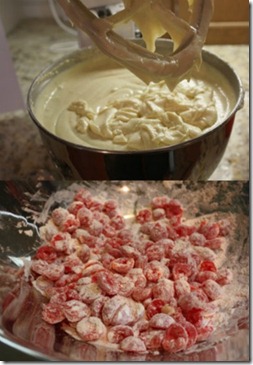Those of you who have been reading my blog for a long time already know about my Christmas favorite, Bishop’s Bread. It’s something I make every single year – because I don’t like fruitcake. You have to understand – I cannot stand those pieces of candied fruit things. This, however, is made with maraschino cherries, chocolate chips and walnuts. Okay? NOT fruitcake!
So why did I make something different than the old standby, you ask? Well, because I was reading the King Arthur Flour blog, called Baking Banter. And they did a write-up about a Golden Fruitcake they developed – about how and why they made theirs the way they did – and with a different batter to hold it together. That was what got my attention – the batter. Last year when I made my Bishop’s Bread, I thought the cake part was just too dry. I’ve noted that a couple of times over the years, but never really knew what to do about it, so I did nothing.
But reading their blog got me to thinking and I decided I had to try it. Theirs has you soak the fruits in brandy (raisins, cranberries, dried apricots and oh-yuk – candied red cherries – all things I never put in MY bishop’s bread). It has 5 eggs in the batter. And corn syrup. Some Fiori de Sicilia (a flavoring available from King Arthur’s that I’ve had in my refrigerator for about 5 years – it’s a citrusy vanilla, sort of). And it has milk in the batter too.
With all that in my head, I just switched out their batter, and used their proportions of fruit/nuts (about 7 cups for a regular 2-loaf recipe). I also added in some dried cranberries (but decided after the fact that I didn’t like that addition at all). I did soak the maraschino cherries in brandy (and the recipe has you add whatever leftover brandy there is into the batter), but I discovered with my first batch that when my fruit mixture didn’t absorb any of the brandy, of course, the batter was too wet. The better part of the first batch went into the trash.

 Before I made my second test batch I did two things: (1) I reduced the amount of brandy altogether – since it was just for flavoring anyway – I didn’t need that much; and (2) I researched the web to find out the internal temperature of fruitcake – when it’s finished. Since I’ve now invested in one of those fancy-dancy instant-read Thermapen thermometers (above), I’ve been using it for several things. And it was just the best tool for this. The answer to my online query was 200°. Even with fruit in it – you want the internal temp of fruitcake to be 200°. Knowing that, I found that in my particular bread pans, it took 96 minutes to reach that temp. Their recipe suggested 50-80 minutes baking time. At 300° it took mine a whole lot longer, obviously. Why? Don’t know, but it did and does. In the second batch I used Convection Bake and it took less time, but it browned the bread way too much, so half way through I reverted it to regular Bake and it seemed to be fine although I did have to remove it sooner. I won’t use that method again, though.
Before I made my second test batch I did two things: (1) I reduced the amount of brandy altogether – since it was just for flavoring anyway – I didn’t need that much; and (2) I researched the web to find out the internal temperature of fruitcake – when it’s finished. Since I’ve now invested in one of those fancy-dancy instant-read Thermapen thermometers (above), I’ve been using it for several things. And it was just the best tool for this. The answer to my online query was 200°. Even with fruit in it – you want the internal temp of fruitcake to be 200°. Knowing that, I found that in my particular bread pans, it took 96 minutes to reach that temp. Their recipe suggested 50-80 minutes baking time. At 300° it took mine a whole lot longer, obviously. Why? Don’t know, but it did and does. In the second batch I used Convection Bake and it took less time, but it browned the bread way too much, so half way through I reverted it to regular Bake and it seemed to be fine although I did have to remove it sooner. I won’t use that method again, though.
The bread has a more tender crumb – I like that part of it. You’ll notice that in the picture at top the bread crumbled a bit. I cut slices before the bread had cooled enough and the edges were still almost crispy. Once I’d wrapped it up and let it sit overnight it sliced just fine. So, I think I’ll be making this version from now on. My friend Cherrie came over the other day and we baked and baked – we made a double batch of this Golden Bishop’s Bread, and we made two batches of our other important Christmas favorite, the Chocolate Almond Saltine Toffee (cookies). We’ll get together one more time in early December to make some of our other favorites – and Cherrie has a new recipe to try too.
What I liked about this version: the brandy flavor, plus the Flora di Sicilia flavor too (but if you don’t have that, no worries, just use vanilla), the tender crumb. Even the freshly grated nutmeg gives a very subtle under-note to the bread. Altogether good stuff!
What I didn’t like: well, it does take a long time to bake, but I think my old version took 90 minutes, so what’s 6 minutes?
MasterCook import file – click link to run MC or right click to save file
Golden Bishop’s Bread
Recipe By: Adapted significantly from King Arthur Flour, 2011
Serving Size: 36
NOTES: You can use your own combination of fruit and nuts – like pecans or macadamia nuts. Use carob chips if you want. If you’re not a fan of maraschino cherries, use dried cherries (soak them in the brandy). Add dates, crystallized ginger, white chocolate chips or dried apricots if you like it. For the 2-bread-pan recipe, use about 7 or so cups of these add-ins – that’s the proportion. Make it whatever way YOU like. You can also adjust the proportion of these add-ins: like more chocolate? Less nuts? Make it your own.
FRUIT and NUTS:
2 1/2 cups chocolate chips
2 1/2 cups maraschino cherries — halved, drained
2 1/2 cups walnuts — chopped
CAKE BATTER:
1 cup unsalted butter — softened
1 3/4 cups sugar
4 tablespoons light corn syrup
2 teaspoons baking powder
1 teaspoon salt
1/2 teaspoon freshly ground nutmeg
1/8 teaspoon Fiori di Sicilia — optional (or substitute vanilla)
4 large eggs
3 3/4 cups all-purpose flour
6 tablespoons brandy
1 cup milk
1. Preheat oven to 300°. Butter two bread pans and line the bottoms with parchment paper.
2. In a medium-sized bowl add the drained maraschino cherries, chocolate chips and walnuts.
3. In a large bowl cream together the unsalted butter, sugar, corn syrup, baking powder, salt, nutmeg and flavoring. Add eggs, and mix at medium to high speed until the mixture is light and cream colored.
4. Measure out the flour in a separate bowl. Scoop about 1/2 cup of the flour into the bowl containing the fruit and mix gently but thoroughly.
5. With the mixer on low speed alternately add the remaining flour and milk. At the last slowly add in the brandy. Using a spoon (not the mixer) add in the fruit and nuts, and mix gently but thoroughly. Try not to mash any of the maraschino cherries as that will turn the batter a pinkish color.
6. Pour the batter into the two bread pans, and gently level the batter.
7. Bake for about 80-95 minutes (depending on your oven) until the top is golden brown and a toothpick comes out clean (it may pick up some chocolate – it’s the batter you want to be cooked through). Alternatively, use an instant-read thermometer and bake the cake until it reaches 200°, testing every 5 minutes starting at 80 minutes.
8. Remove bread and allow to sit on a rack for 30 minutes. Gently slide a thin spatula along all 4 sides of each loaf and gently turn the pan over into your wide spread hand. Jiggle slightly to remove the bread and very gently set on the rack and let it cool completely, about 2 hours. Wrap in plastic wrap, then in heavy-duty foil. Will keep a few days at room temp, or ideally, freeze loaves until you need them. You can also seal them well and store in refrigerator for up to a month. If you want to keep these extra moist, brush the loaves with additional brandy once a week until you’ve finished eating them.
Per Serving: 302 Calories; 16g Fat (44.9% calories from fat); 5g Protein; 38g Carbohydrate; 2g Dietary Fiber; 38mg Cholesterol; 111mg Sodium.







Linda Murray
said on September 2nd, 2015:
I too love Bishop Bread without the citrus in it. My recipe is a litte different than yours so I thought I would share it. Doesnt have any alcohol in it but very good none the less. Give it a try and you will be hooked, guaranteed.
Bishop Bread (fruitcake)
1 2/3 c chocolate chips
2 c chopped walnuts
1 1/3 c chopped dates (1-8oz box)
1 c raisins
½ c green maraschino cherries (drained and halved)
½ c red maraschino cherries (drained and halved)
1 t baking soda
3 eggs
1 t salt
¾ c sugar
½ c water( you can cherry juice to make up the ½ c water)
1 ¾ c flour
* optional 1 T rum
Mix all dry ingredients together. Mix all fruit together well. Combine two bowls and toss. Pour into angel food pan or two loaf pans that have been sprayed with pam not buttered. DO NOT use Bundt pan. Bake at 300 degrees for 1 ½ hrs. Should be soft when comes out. Let sit for a bit before releasing it. Cuts best when cooled. Store in tin for several weeks.
Did you see my “regular” Bishop’s Bread recipe here on my blog?
https://tastingspoons.com/archives/215
It’s got the walnuts and chocolate chips. I don’t much like dates, so I deleted that from the get-go back in the 60’s when I acquired the recipe. I’ve never used raisins – I prefer the chips/walnuts/cherries version. Thanks for commenting . . . carolyn t
Jerri
said on January 25th, 2019:
There is no mention when you add eggs. I added after creaming butter and sugar.
Oh, goodness, I must have missed that. Thank you for noticing. I’ll go fix it! . . . carolyn t